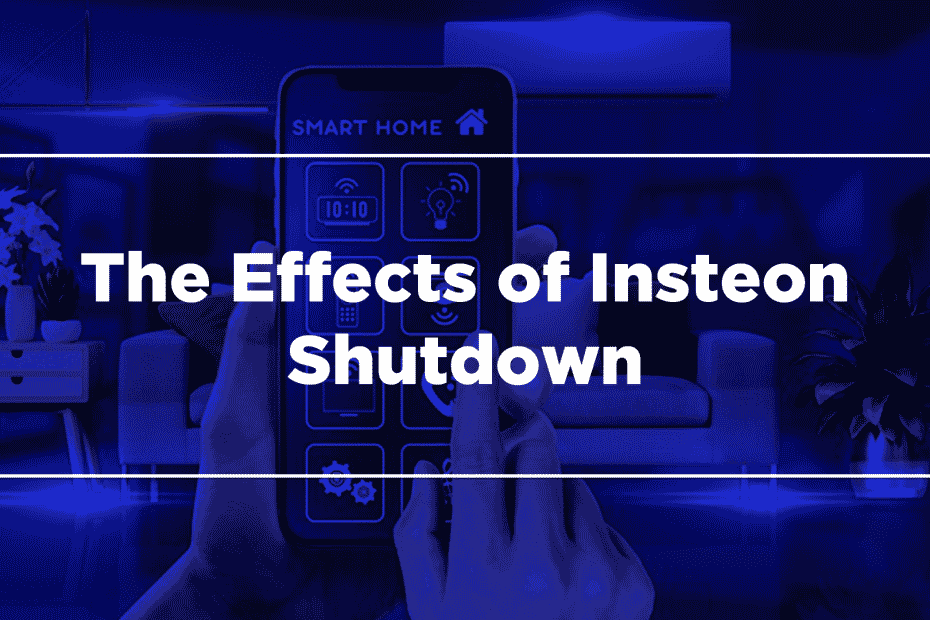When talking about smart homes, many often immediately think of Insteon. The company is — or in this case, was — associated with smart homes and proprietary communication standards. But until just recently, Insteon is now seen as that company that abandoned ship on their loyal customers.

Why did Insteon Shutdown?
Without any warnings whatsoever to its many users, the smart-lightning company abruptly shut down. The wide array of Insteon’s dimmer outlets, light switches, smart home sensors, and wall keypads lost connection to the company’s servers.
Not only that, Insteon seemingly shut down its user forums and went as far as to wipe its leadership page from its website. The C-rank management has also removed from their LinkedIn profiles any mention of affiliations with the company and its parent company, SmartLabs. Requests for comments were also shut down. But former CEO Rob Lilleness responded when approached via LinkedIn, saying, “Unfortunately, I am no longer involved with the company.”
With over 1.3 million users, Insteon was one of the smaller IoT players in the market. But this sudden closing is inexcusable despite their size or footprint. The company released an update only a week after their services went down. They claim that the pandemic caused the company’s financial ruin but did not mention any solutions for the people affected. All of these are no surprise to anyone, though.
What are the Effects of the Shutdown?
Well…one can say that there is an angry mob on Insteon’s digital doorstep, and rightfully so. After all, many are left in the dark (both literally and figuratively). But what seemed to be the major blow was Insteon’s homepage claiming that all of their services are operational.
But despite such an anger-causing commotion, it isn’t likely that the popularity of IoT devices like lighting and security cameras will deteriorate. IDC’s report even reassures smart home users of this unlikelihood. According to their report, the global market for smart home devices grew about 12% just in 2021. And if their projections are correct, then the smart home industry is looking at a 10% annual growth until 2026. Moreover, lighting devices will see the biggest increase in demand with a growth of more than 23% per annum.
Furthermore, IDC, along with other analysts and reporters alike, note that a standardized approach called ‘Matter’ will help in future proofing smart homes. Such an emergence in smart home systems will enable ‘Matter’ compatible devices to fold into other ecosystems in case another provider shuts down. But ‘Matter’ is still unavailable and will be, no earlier than the end of 2022.
On other pressing issues, many have voiced their concerns about what happened. Ars Technica claimed that the sudden shutdown of the app and servers of Insteon is rather “shameful.” Being one of the first to track the shutdown, Stacey Higgenbotham of “Stacey on IoT ” cast doubts on the entire smart home industry. What she wrote indicates that there is no guarantee that any smart home product that people buy will “stand the test of time.” She also mentioned how ‘Matter’ may or may not change that. Another concern is from Johannes Himmelreigh, a tech ethicist. He thinks that companies like Insteon may be preying on their unknowing customers while their products are still in the works.

Analysts warn customers to be overly cautious when working with smaller companies on any form of tech. Insteon’s abrupt shutdown is not the first case. Lowe has also shut down its Iris smart home platform prior to Insteon’s. However, the marring difference is that Lowe had the courtesy to warn its customers and even provided Visa gift cards during their migration.
Surely enough, customers would be wise to heed such warnings from analysts. Because even in the industrial segment of IoT, malicious activities are happening. For instance, there are IT managers that build redundancies so as not to fall short when a vendor’s approach falls through.
What are the Alternatives?
Now what? Anyone using Insteon products is at a dead end.
First off, do not (and with much emphasis) factory reset the Insteon hub. Otherwise, users will be rendering their Insteon hub useless. It will not be able to connect to the servers anymore by doing so. Secondly, users can choose between one of two options. They can either replace their hardware or integrate their devices into another platform.
The latter varies depending on specific devices, hardware, and sensors the user possesses. Switching over to Home Assistant is a solid option. But this requires a Raspberry Pi and the free Home Assistant software that will act as the new brain of a user’s smart home. Simply follow these steps to integrate the supported Insteon device.
Another solution would be purchasing a HOOBS box. HOOBs, which stands for Homebridge Out of the Box, is another self-managed hub system that is geared more toward Apple HomeKit integration. Nevertheless, the company has been working on an Insteon integration because of what happened. This future integration is a plugin and is similar to Home Assistant. Users can also expect more than 2 000 plugins aside from the Insteon gear.
Users can also check out HomeSeer, which recently touted Insteon compatibility. This company offers a smart hub that supports hundreds of smart home products, digital assistants, and Z-Wave. Lastly, users can opt for a more local-control-oriented hub. The Hubitat hub has been upgraded over time to allow more functionality for users. While there is no native Insteon support for this one, there is an available community plugin. Hubitat also works well with Bluetooth, WiFi devices, Zigbee, and Z-Wave.
Wrapping Up: Is Insteon Coming Back?
Since the code, certifications, and documentation are stuck in the liquidation process, people relying on the company won’t be able to keep their homes functioning. So it is clear as day that users need to jump ship and consider the range of options in front of them. Decisions will mostly be influenced by how much users have to spare and have invested in Insteon.

If you only have a few Insteon devices, using a completely different platform would be best. For Apple users, you can try HomeKit. As for Android users, you can check out Google Home or Amazon Alexa.
But if you have invested hundreds (maybe more) into your Insteon gear, you can start trying out any of the above-mentioned self-managed options. This way, it’ll be less expensive and not a full-on discarding of Insteon devices, no matter how upset or angry you might be.
